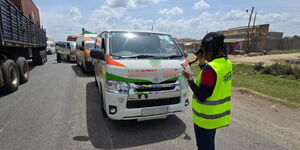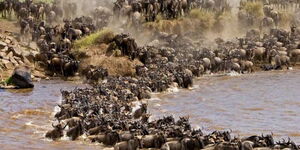A 20-year-old man is nursing injuries after he was trampled by elephants that had taken over Isiolo town on the morning of Tuesday, August 17.
Video clips seen by Kenyans.co.ke showed the two elephants roaming the streets of the quiet town hence sending the area residents into a frenzy.
The two animals reportedly sneaked out of Buffalo Springs National Reserve in search of water and pasture in the drought-ravaged county.
In the first clip, motorists are seen swerving aside to allow the animals the right of way while people look for a place to hide from the wild animals.
The injured youth had attempted to chases the animals away when the attack happened.
Shortly after the animals took to the streets, officers from the Kenya Wildlife Service (KWS) responded and successfully drove them back to the reserve.
The town has over the years suffered from human-wildlife conflict which often results in deaths of human beings as well as the destruction of property and crops.
A February 2021 study led by the University of Kent's Durrell Institute of Conservation and Ecology (DICE) found that elephants in Kenya, particularly from the Masai Mara Game Park, often raid crops near their habitats.
"The number of crop-raiding incidents increased by 49% over the 15 years, but crop damage per incident dropped by 83%. This could be because farmers are better prepared to frighten off elephants.
"It could also be because landcover change makes it harder for elephants to hide in forest patches, and this spread of farmland and loss of forest to illegal charcoal clearing means that more of the crop-raiding incidents are taking place closer to the protected area," read the findings in part.
Individuals affected by attacks from wild animals, however, can file for compensation from KWS as per the third schedule of Wildlife Conservation & Management Act (WCMA) 2013.
The first step that an affected person should take is to report the incident to the nearest Kenya Wildlife Service (KWS) station within 24 hours of occurrence.
A KWS officer then verifies the claim and issues the claimant with a compensation form. Depending on the type of damage, different government officials are involved in the verification process.
Cases dealing with crop destruction are dealt with by agricultural and land officers. Cases that involve human death or injury are handled by medical officers and the National Police officers (NPS) while cases involving property damage are dealt with by land officers and valuation officers.
Once filled, the forms are returned within 30 days for verification before being forwarded to the County Wildlife Compensation Committee (CWCC) which eventually determines the compensation.
Below is the video:
{"preview_thumbnail":"/files/styles/video_embed_wysiwyg_preview/public/video_thumbnails/efciFWK-7wo.jpg?itok=UL3AT19H","video_url":"","settings":{"responsive":1,"width":"854","height":"480","autoplay":0},"settings_summary":["Embedded Video (Responsive)."]}












